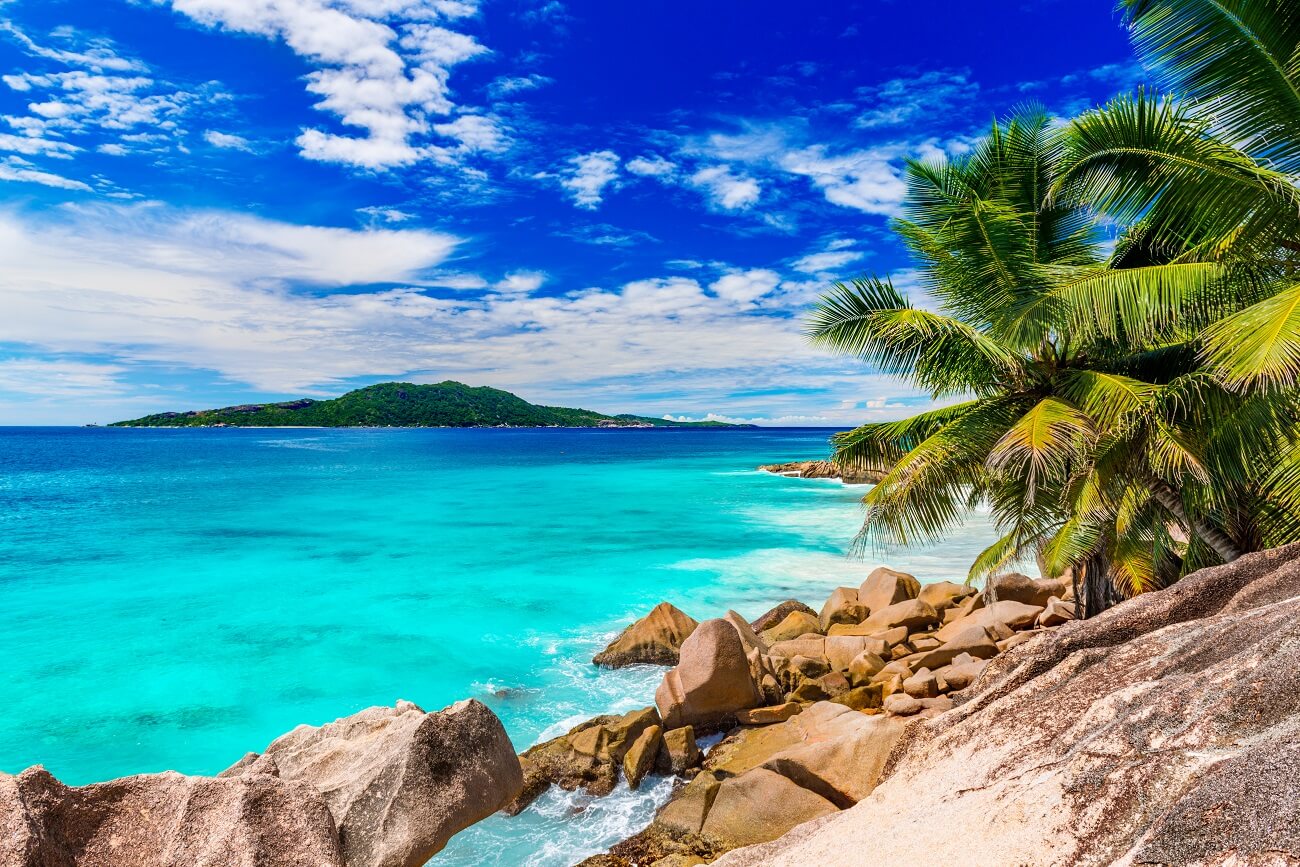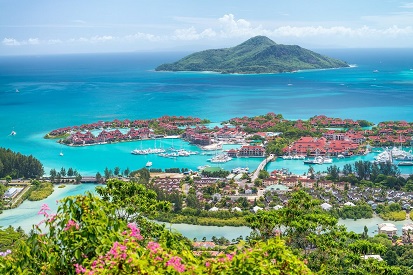

La Digue is an eco-island with incredible beaches, where there are practically no cars, and the main transport is bicycles and oxcarts. It combines the charm of the Seychelles with the authenticity of the archipelago.
The tropical island is located 6 km southeast of Praslin. It can be reached in 15 minutes by boat. La Digue is the fourth largest island in the archipelago. It is very small - only 5 km long and 3 km wide, but in many ways it is unique. For example, it rains less often here than on other islands. Beaches surrounded by granite rocks, hills covered with coconut palms, exotic trees, country roads where almost no cars drive...

Depositphotos
Infrastructure of La Digue Island
The island was named after the ship on which French naval officer Marc-Joseph arrived in 1768 Marion Fran. For three years La Digue was considered French territory, but then it left the British leadership. Today the small island is home to just over 3,000 people.
- The main sources of income for local residents are fishing, agriculture and, of course, tourism.
- The only large village on the island is La Reunion, where in addition to the beach of the same name there are banks, shops, restaurants, cafes and bicycle rentals. There are two more villages in the northern part of La Digue: La Passe and L'Union. Discover charming Creole houses and a leisurely local lifestyle that is still authentic. In the villages you will find small restaurants offering traditional Seychellois cuisine. A visit to these three villages will allow you to fully immerse yourself in the local culture. And as a souvenir, take vanilla and spices from the Seychelles.
- If we talk about attractions in the traditional sense, then La Digue is a little lacking in them. But the island can boast of beautiful white sandy beaches, incredible bays, granite cliffs and lush vegetation.
- Accommodation on the island - for every taste. But most accommodation options are quite modest: these are small hotels, guest houses, which are mainly located on the west coast, in La Passa. Hotels and villas are cozy and comfortable, surrounded by green tropical forests, a stone's throw from the excellent beaches of the Seychelles.
- The tourist information office is located in La Passa. It is open Monday to Friday from 8:00 to 17:00 and Saturday from 9:00 to 12:00.

Depositphotos
Beaches of La Digue Island
The turquoise water is ideal for swimming and snorkeling. Many of La Digue's beaches are so beautiful they look like postcards. However, the currents are stronger on the eastern side of the island and warning signs posted on some of the island's beaches should be taken seriously.
The island is almost completely surrounded by coral reefs, so many coves offer swimming or snorkeling. Visit Petite Anse, Anse Cocos or Anse Nord Beaches, fringed with coconut palms. South-east of La Digue is the excellent Grand Anse beach. But be careful with the currents when the sea is rough!
- Anse Source d'Argent is the most famous beach. This is what we see on all the postcards of the dream archipelago. This is a real paradise beach with huge granite rocks, white sand, clear waters and coconut palms. It is often chosen by newlyweds both for a photo shoot and for a wedding ceremony. Large blocks of granite line the powdery sand beach. Entrance to the beach is paid.
- Anse Nord is also worth a visit during sunset: the view will take your breath away! It is located north of La Digue and offers wonderful views of Praslin. The beach is protected by a coral reef and is perfect for families with children. The sea is calm and shallow at low tide. On the beach you can visit a bar and a shop. And this is a place that is recommended for scuba diving.
- Anse Patates. One of the most beautiful beaches on the island. From the road you have a bird's eye view of this magnificent bay. It is advisable to come here during low tide, since the sandbar is not very wide, and you need to wear shoes when entering the water due to the abundance of corals and sea urchins. But as soon as you put on your fins, mask and snorkel, you will feel like you are in an aquarium among colorful fish of extraordinary beauty!

Depositphotos
Things to do on La Dighe in Seychelles
Visit a former plantation
Former coconut and vanilla plantation, also called Union Estate, simply Must see for visiting La Digue. Entrance fee is about 100 Seychellois rupees (less than 10 euros). The former plantation has become a land of attractions. You will see how vanilla grows and is pollinated by hand. And how coconut oil is made from dried coconut pulp in an old ox-drawn mill. You can buy it directly on the spot. By the way, this oil is known for its benefits; it can also be found in small shops on the island. Aldabra giant tortoises Seychelles archipelago live in an enclosure: get ready for a photo shoot!
The planter's house, designed in the style of French colonial architecture, has been preserved. This national monument commemorates the French occupation of the island. The owners of the house were a Mauritian family who became rich after settling on the island. The beautiful house was built from valuable wood and palm leaves. Finally, admire the impressive giant Union Rock, rising 40m high and estimated to be 700 million years old!
The park can be easily visited on foot, by bicycle or by oxcart.

Depositphotos
Eagle's Nest: La Digue from above
In the eastern part of La Digue is the 333-meter peak Nid d'Aigle or Eagle's Nest. This is the highest point of the island. A 4 km walk will take you to the top of the mountain. Once you reach the peak, you will be treated to spectacular views of La Digue and the neighboring islands (Praslin, Felicite, Marianne and sometimes Frigate if the skies are clear). As you walk through this jungle-like rainforest, you may encounter various species of insects, spiders, snails, and even giant centipedes! If you want to walk the entire route, it is advisable to leave early in the morning. If you don’t feel strong enough for a long walk, you can take a taxi part of the way. It is advisable to start your walk early in the morning, as most of the trails are not shaded.

Depositphotos
Walk around the port
Upon arrival in La Digue, you immediately arrive at the port of La Pass. He is very small and very cute! From here begins the main street of the port, dotted with small kiosks selling food, drinks, souvenirs, and playing music performed in Seychellois Creole.
You will also see colonial houses with typical Seychellois architecture. The port is important not only for tourist ferries. It is increasingly becoming a center for boat trips and diving excursions to other islands in the north-east of the Seychelles. A dam is provided to protect against the often stormy northwest monsoons.

Depositphotos
Cycle around the island
The bicycle is the main means of transport on the island. It’s easy to rent, it costs about 10 euros per day, and it’s cheaper for long-term rentals. With it you can look into all the remote corners of the magical island and visit all the beaches!

Depositphotos
La Nature Reserve Vöv
The south of the island is home to an amazing and rare bird that is found only on La Digue. Her dark blue color and long black tail earned her the nickname “Widow.” This sanctuary was created in 1982 to protect black-tailed beauties. In the heart of the reserve you will also find turtles, swifts and many species of birds. Banana trees, palm trees, vanilla trees and orchids also grow here. You can book a tour of the reserve, during which the guide will tell you about the local fauna and flora in every detail.
Visit nearby islands
Not far from the island there are amazing small islands: Cocos, Grande Seur and Felicite. Be sure to visit them! Organized cruises to neighboring islands are organized for tourists. The approximate cost is 120 euros per person, which also includes diving into the underwater kingdom.
First we go to Cocos, a national marine reserve where you can go snorkeling. Then you are treated to lunch, after which you are taken to the island of Grande Seur and Felicite, where you can walk through a lush forest and swim among fish and turtles.

Depositphotos
Transport to La Digue
This is an eco-island where the government has decided not to develop road transport and abandon scooters. There are practically no cars on the island. There are no more than a few dozen of them. Luckily, most places on the island can be reached on foot in about an hour. Therefore, tourists can choose the following travel options:
- As we wrote, this is the most popular mode of transport in La Digue. If you're staying at a hotel or guesthouse, you can usually rent a bike without any problems. But beware of their condition: sometimes the bikes are quite old.
- Rarely found on the island because there is little motorized transport on La Digue. To transport tourists on the island there are no more than 30 cars.
- Hotel electric transport. On the island, hotels provide electric transportation, similar to golf carts. If you are checking into a hotel, he will pick you up from the port and take you and your luggage to the hotel.
- Such carts were once the main means of transport in La Digue. Now there are a few of them left, intended for tourist trips. This is a tourist attraction that is quite popular. At the port of La Pass, oxcarts are already waiting for tourists and are ready to take them to the hotel.

Depositphotos
How to get to La Digue
Just a few years ago, the journey to La Digue was long and tedious. But now it takes only 15-20 minutes from Praslin by boat or an hour by catamaran from Mahe.
- Mahe Island is 45 km away. Cat ferries operate Cocos, which can take you to La Digue in 1 hour 10 minutes. The cost is about 60 euros per person one way.
- The journey from Praslin to La Digue takes 15 minutes (the distance between the two islands is 7 km) and costs about 15 euros one way. Most often Cat boats Rose enter Praslin.
- Although there is no airport or airfield on the island, there is a runway for helicopters! Flights are operated by ZilAir (from Mahe or Praslin), which connects at least 11 Seychelles islands.

Depositphotos
La Digue is a unique and incredibly beautiful island, the hallmark of Seychelles with breathtaking landscapes, where you can fully enjoy every moment and the unique charm of the tropics. Plan your trip in advance!
More articles
- Joali Being the first wellness island in the Maldives
- The best hotels in Bali with villas on the rocks
- Best Bali Hotels Adults Only
- The best hotels in Bali for family holidays
- The best family hotels in Seychelles
- Java Island on your own - where to go and the main tips
- Top 5 Sustainable Tourism Destinations in Indonesia
- Holidays in Bali: top 22 things to do on the island
- Nyepi in Bali - New Year or Day of Silence
- Rains in Bali: pros and cons of the wet season



